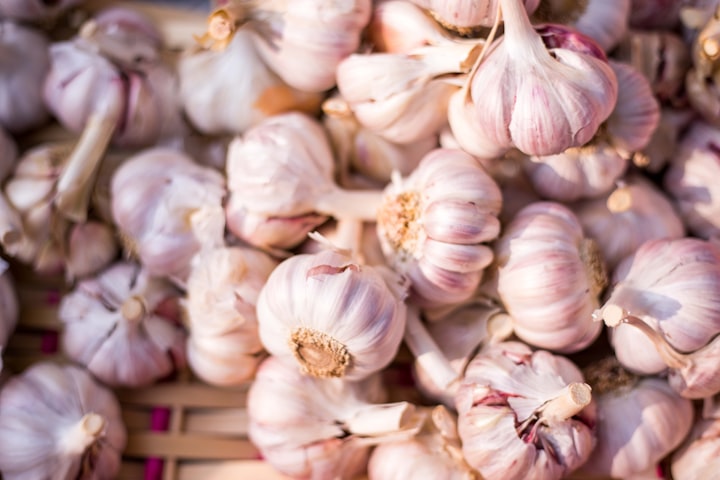Could this Old Wives' Tale bring an end to antibiotic resistance?
How garlic holds the potential to become the world's most effective and versatile antibiotic

What was once deemed a mere Old Wives' Tale, garlic (Allium sativum) has been the subject of focus in studies aiming to tackle worldwide antibiotic-resistance.
The improper use of antibiotics, like penicillin, in healthcare and agriculture has led to an increasing number of global deaths from infectious diseases, such as pneumonia and sepsis. Antibiotics are designed to specifically target certain types of bacteria that cause fatal infections; however, they are often prescribed before a diagnosis of a bacterial infection is confirmed. More about how antibiotic-resistance occurs can be read in the links below (Ventola, 2015).
The problem with antibiotics being prescribed before a diagnosis is that the type of antibiotic might not be the right match for the type of bacteria causing the infection. Moreover, antibiotics that target a wider spectrum of bacteria can harm our good bacteria, which boost our immune system, nutrition, and mental health (Aslam, et al. 2018). This, in combination with the increasingly concerning threat of antibiotic-resistance, desperately calls for a new approach to treating common infections; this would allow the more specific antibiotics to be saved for treating life-threatening infections.
Garlic (Allium sativum) has been used to treat a variety of ailments since ancient Egypt. The so-called 'Old Wives' of these times would care for the sick and the wounded; these carers noticed that if crushed, raw garlic was applied to wounds, the previously red, swollen wounds would heal and the inflicted would recover.
Since the discovery of antibiotics, such as penicillin, the more traditional methods of treating infectious were dismissed as Old Wives' Tales and deemed ineffective, as there was no documented scientific evidence to prove its effectiveness. However, in Sir Alexander Fleming's Nobel Prize speech, he warned of the dangers of resistance to the drug. This warning was overlooked, as there was a dire need for medicine that would treat the plethora of infections incurred by the trench-dwelling soldiers. As penicillin worked rapidly to cure many soldiers of such inflictions, natural remedies became a thing of the past.
In recent years, scientists have been exploring the potential of garlic as an antibiotic, as we now have the tools to test this sufficiently. Research scientists have discovered that crushed, raw garlic successfully kills bacteria that cause fatal infections, including Salmonella, Listeria, and E. coli O157:H7 (Adler and Beuchat, 2002). Furthermore, garlic killed bacteria that were resistant to multiple antibiotics, known as 'superbugs', and no signs of resistance to garlic were seen in any of their tests (Wallock-Richards, et al. 2014).
Unlike antibiotics, which only affect bacteria, garlic has been shown to be effective against other infectious agents, including viruses and fungi (Leontiev, et al. 2018). This means that for the common infections that are not caused by bacteria, such as the flu, we could use garlic to help our immune systems fight off these common infections. If we are able to recover quickly from such ailments, we could potentially reduce the number of visits to the doctors, and therefore, reduce the rate at which antibiotics are unnecessarily prescribed. In turn, fewer bacteria will be exposed to antibiotics, and the occurrence of resistance being transferred will potentially be reduced.
Of course, people have concerns about taking natural remedies because they might interact with medication; however, when garlic is used in combination with prescribed antibiotics, they work together to treat an infection more effectively, which is known as synergy (Li, et al. 2015). This means that adding fresh, raw, crushed garlic into our diet could ward off all types of infections, and presents no known concern regarding prescribed medication for serious infections.
Embracing this newfound potential of natural remedies could help us to combat antibiotic resistance, worldwide. One must stress that adding garlic into your daily diet is not aimed to replace antibiotics that are prescribed for infections. Instead, it should serve as a supportive measure to reduce the need for prescribed antibiotics, thus enhancing their effectiveness when we must use them to treat infections. Please consult your respective physician if you have any further concerns with introducing fresh, raw, crushed garlic into your diet.
References
Adler BB and Beuchat LR. Death of Salmonella, Escherichia coli O157:H7, and Listeria monocytogenes in garlic butter as affected by storage temperature. Journal of Food Protection 2002;65(12):1976-1980.
Aslam H, Green J, Jacka FN, Collier F, Berk M, Pasco J and Dawson SL. Fermented foods, the guy and mental health: a mechanistic overview with implications for depression and anxiety. Nutritional Neuroscience 2020;23(9):659-671.
Leontiev R, Hohaus N, Jacob C, Gruhlke MCH and Slusarenko AJ. A Comparison of the Antibacterial and Antifungal Activities of Thiosulfinate Analogues of Allicin. Nature 2018;8:6763.
Li G, Ma X, Deng L, Zhao X, Wei Y, Gao Z, Jia J, Xu J and Sun C. Fresh Garlic Extract Enhances the Antimicrobial Activities of Antibiotics on Resistant Strains in Vitro. Jundishapur Journal of Microbiology 2015;8(5):e14818.
Ventola CL. The Antibiotic Resistance Crisis. Pharmacy & Therapeutics 2015;40(4):277-283.
Wallock-Richards D, Doherty CJ, Doherty L, Clarke DJ, Place M, Govan JRW and Campopiano DJ. Garlic Revisited: Antimicrobial Activity of Allicin-Containing Garlic Extracts against Burkholderia cepacia Complex. PLoS One 2013;9(12):e112726.





Comments
There are no comments for this story
Be the first to respond and start the conversation.